Get PeakVisor App
Sign In
Search by GPS coordinates
- Latitude
- ° ' ''
- Longitude
- ° ' ''
- Units of Length

Yes
Cancel
Share ×

Scan the QR code and open PeakVisor on your phone
❤ Wishlist ×
Choose
Delete
Jiuzhai Valley (九寨沟), which literally translates to “valley of nine stockaded villages” in Chinese, is a real-life fairyland in Sichuan Province in southwestern China. Famous for its multi-colored lakes set against snow-capped peaks, this UNESCO World Heritage site contains three named mountains, the highest and most prominent of which is Garze Konka (4,558 m/ ft).
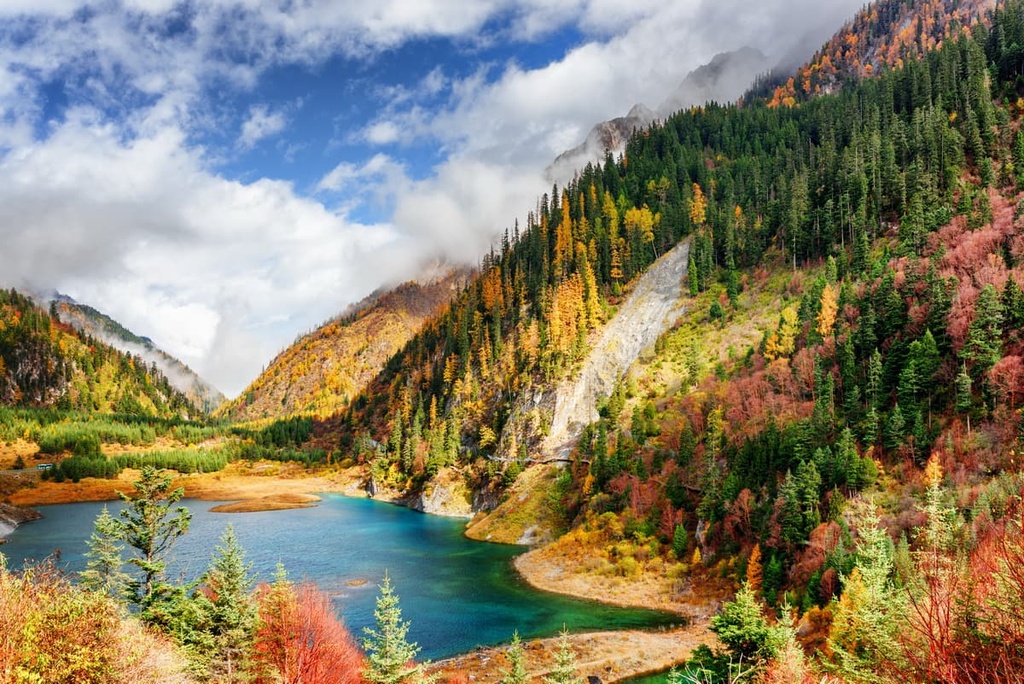
Jiuzhai Valley National Park occupies an area of 720 square km (278 square mi) in southwestern China. The park is located in the Aba Tibetan and Qiang Autonomous Prefecture (阿坝藏族羌族自治州) of Sichuan Province, with an additional buffer zone of about 600 square km (232 square mi).
The park is located about 330 km (205 mi) north of Chengdu (成都), the provincial capital. It is also part of the Min Mountains (岷山), a subrange of the extensive Hengduan Mountains (横断山脉) in southwestern China.
The area is in the transition zone between the Qinghai-Tibetan Plateau and the Sichuan Basin. The elevation on the northern end of the park is around 2,000 meters (6,500 ft) while the southern end of the park has an average elevation that’s around 4,500 meters (14,760 ft).
The core area of the park is made up of three connecting valleys that an inverted Y shape: Shuzheng Valley (树正沟), Rize Valley (日则沟), and Zechawa Valley (则查洼沟). A fourth valley, Zharu Valley (扎如沟), branches off from Shuzheng Valley and has been opened to tourists since 2009. Tucked in the valleys are 108 high elevation lakes and 17 waterfalls.
The park offers more than 70 km (43 mi) of wooden boardwalks as well as a shuttle bus service that offers access to the major attractions. It is also served by Jiuzhai Huanglong Airport, which is located 88 km (55 mi) away.
Tourists are not allowed to stay overnight inside the park unless they join a guided camping trip to Zharu Valley. Plenty of accommodation options, from basic shared dorms to five-star international chains, are available just outside the park entrance.

About 400 million years ago, the Jiuzhai Valley area was a shallow sea teeming with ancient marine life. The seabed contained layer upon layer of calcium deposits that gradually accumulated to carbonate rocks as thick as 4,000 meters (13,123 ft).
The collision of the Eurasian Plate and Indian Plate about 50 million years ago pushed up the Earth’s crust in an uneven manner that set the stage for the formation of a panoply of dramatic geological features.
Apart from tectonic activities, glacial and hydrological forces also play a part in shaping the constantly evolving landscape in the region. During the last glacial maximum, the area was covered with glaciers. Even though the glaciers have long since disappeared, they left behind steep-sided ridges, U-shaped valleys, moraines, and glacial lakes.
Water has always been a dominant feature of the landscape and scenery in the region. Abundant rainfall interacted with the carbonate rocks, leading to karst erosion that gave rise to hanging cliffs, waterfalls and an extensive underground water system.
The area contains a copious amount of tufa, a type of limestone that formed as a result of the rapid precipitation of calcium carbonate from freshwater. It settled on rocks, lake beds and even fallen trees in the water, and sometimes built up to become terraces, shoals and dike barriers in the lakes. Microbial organisms on the tufa are the reason behind the stunning colors of the iconic lakes in the park.
That being said, the land in and around Jiuzhai Valley National Park is still tectonically active. Indeed, an earthquake measuring 7.0 on the moment magnitude scale hit the area in August 2017, killing more than 20 people and injuring nearly 500.
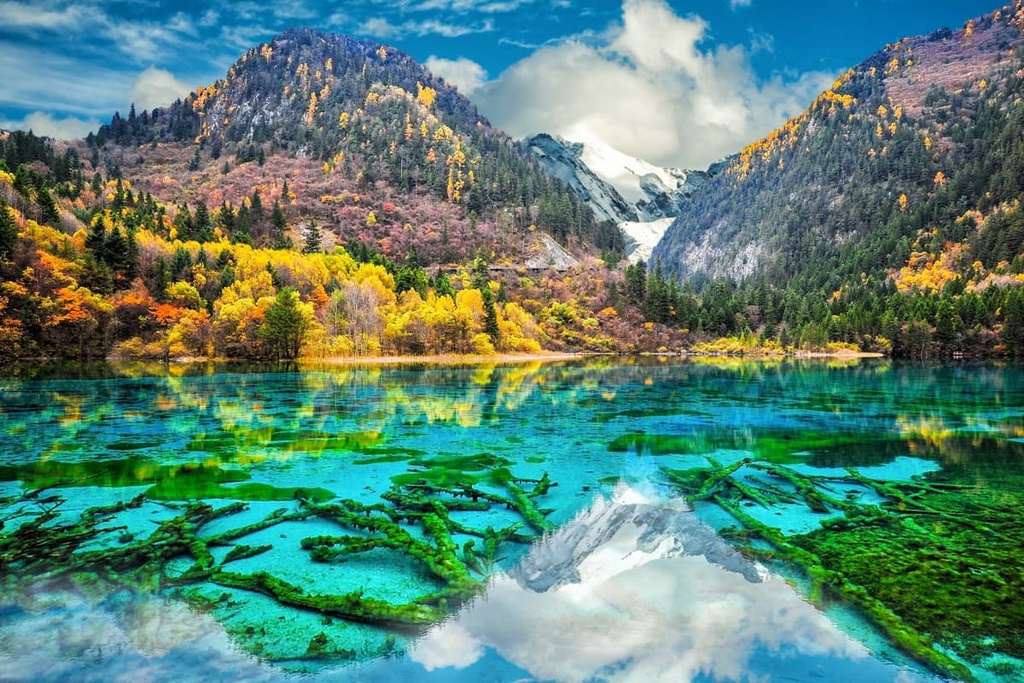
This earthquake caused widespread landslides, the draining of some lakes and the partial collapse of the Nuorilang Waterfalls, the widest waterfall in China. Much of the disturbances to the landscape have since recovered, partly with the aid of human efforts.
Jiuzhai Valley is part of an area in southwestern China that contains one of the most biologically diverse temperate forests in the world. Most of the park is covered with mountain conifers and mixed broadleaf-coniferous forests. Common trees include firs, spruces, pines and oaks.
The wide ranges in elevation in the region have given rise to different types of forests. This includes:
Thanks to an abundance of deciduous species in the region, the vibrant colors of fall vegetation in the park rival those of the lakes. Flowers such as rhododendrons and orchids contribute to the vivid autumnal palette in the region. The park is also a haven for bamboo, ferns and aquatic plants. More than 400 species of algae thrive in the lakes.
Jiuzhai Valley is home to more than a thousand species of animals, including the beloved giant panda, red panda and Sichuan golden monkey. More than 200 species of birds have been recorded in the park, too, such as golden eagle, lesser kestrel, spectacled parrotbill, and snowy-cheeked laughingthrush.

Even though the area teems with lakes and rivers, low water temperatures combined with an exceptionally high mineral content make the park an inhospitable environment for fish. The only recorded fish in Jiuzhai Valley National Park are two rare species of alpine naked carp, which have almost no scales or else the minerals in the water would precipitate on their body.
Logging used to be the main economic activity in the area before it was banned in 1979. Nowadays, the main threat to the flora and fauna in the region is mass tourism.
About 1,000 people, mostly ethnic Tibetans, currently live inside the park. They speak a Tibetan dialect that is quite different from the Tibetan spoken in Lhasa. Out of the nine stockaded villages or “Jiuzhai,” there are three villages readily accessible to tourists in the park, as well as two that are no longer inhabited.
Human activities in the region can be traced back some 3,000 years. The earliest settlers in the region are believed to have migrated from the Tibetan region of Ngari. Their descendants led a semi-pastoral and semi-agricultural lifestyle for centuries until recent decades.
Hemmed in by mountains in a remote part of the country, the locals in the region had little contact with the outside world before Jiuzhai Valley was officially “discovered” in 1972. Extensive logging soon followed but was banned in 1979, and the area was made a national park three years later.
After the park became a UNESCO World Heritage Site in 1992 and a World Biosphere Reserve in 1997, the villagers were not allowed to farm and herd yak. Most of them now earn a living from catering to tourists.
The locals have been practicing the pre-Buddhism religion of Bon (苯教) since the second century BCE. As a shamanistic and animalistic religion indigenous to the Qinghai-Tibetan Plateau, Bon has co-existed and sometimes merged with Tibetan Buddhism since the latter was introduced to the region in the seventh century.

The highest peak in the park, Garze Konka, is considered a holy mountain by the locals. Pilgrimage to the mountain takes place every month on the fifteenth day of the lunar calendar, when pilgrims make their way around the mountain on foot or on horseback in an anti-clockwise direction.
Stupas, prayer wheels, and prayer flags can be seen all over the park. Prayer flags have five colors—each symbolizing an element—that are arranged in order from left to right: blue (sky), white (air), red (fire), green (water) and yellow (earth).
The Zharu Temple (扎如寺), which was dedicated to the Bon religious tradition and, to a lesser extent, Tibetan Buddhism, was built in the late 1500s. It hosts four large-scale religious celebrations every year, including the Mazhi Culture Festival that lasts for nine days in the fourth month of the lunar calendar.
With its well-defined seasons, Jiuzhai Valley has something to offer all year round, between spring flowers and fall foliage, and from refreshingly cool summer temperatures to a snowy winter wonderland. Here are some of the must-see places in the park.
The Shuzheng Valley is the main branch of Jiuzhai Valley. It boasts more than 40 lakes, including a stepped cluster of 19 lakes that form the Shuzheng Lakes. Surrounded by lush vegetation on all sides, the lakes resemble islands of sapphire in a sea of virgin forest. These lakes are fed by the multi-tiered Shuzheng Waterfalls.
The Nuorilang Lakes is another cluster in the valley. The tranquil waters of the lakes turn into raging curtains as they pour down the 320-meter (1,050-foot) wide Nuorilang Waterfalls, one of the most visited attractions in the park. Many visitors find the waterfalls even more impressive when they freeze solid during the coldest months of the year.
Other popular nearby sights include Sleeping Dragon Lake, Reed lake, Bonsai Shoal, and Shuzheng Stockaded Village.

This stretch of land in the Rize Valley boasts diverse scenery. This includes the Primeval Forest (原始森林), a mist-shrouded haven of ancient trees at almost 3,000 m (9,843 ft) above sea level. Among the firs and spruces in the valley, the endemic Chinese red birch (Betula albosinensis) is a bit of a standout with its reddish peeling bark.
The Pearl Shoal is a 160-meter (525-foot) wide area of calcareous tufa deposits, whose rough surface causes pearl-like water drops to bounce around as water tumbles down the gentle slope. The mild gradient soon gives way to a vertical drop at Pearl Waterfalls. These falls are known for their sheer volume of water, which creates a deafening sound that fits well with the impressive view of the falls themselves.
Rize Valley has a fair share of fairytale lakes like the Five Flower Lake, which is especially prized for the fallen trees under its crystalline waters. Other nearby lakes include Grass Lake, Arrow Bamboo Lake, Panda Lake, and Mirror Lake.

In the Zechawa Valley, the biggest and smallest lakes in the park are just 1 km (0.6 mi) apart. With a length of 7.5 km (4.7 mi), Long Lake is not only the longest and largest lake in the park, but also the deepest with a depth of nearly 100 m (328 ft). It is flanked by snow-capped peaks and has its own version of the Loch Ness Monster.
The Five-color Pond, on the other hand, is only 100 m (328 ft) long and 6.6 m (21.7 ft) deep. Despite its size, it is arguably the most colorful lake in Jiuzhai Valley. It never freezes since it is replenished by warm underground water. This lake and Five Flower Lake in Rize Valley are often considered the most beautiful lakes in the park
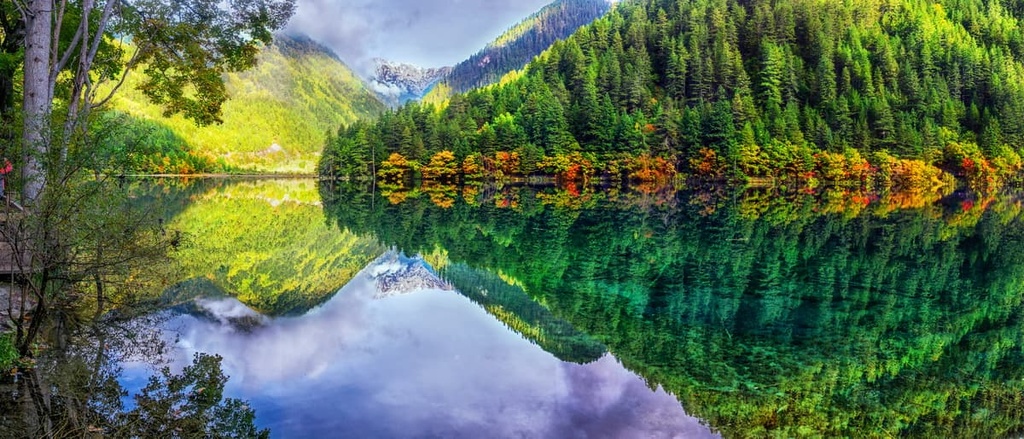
The Zharu Valley was opened to tourists much later than the others in the park. Therefore, it is the least well-known and least visited of all the park’s valleys.
It is free from the big tour groups that throng the other valleys as this branch is not yet served by shuttle buses. With a pristine environment that makes up for its lack of colorful lakes, this valley is billed as the premier destination for explorers and adventurers.
Its attractions include Zharu Temple, the sacred mountain of Garze Konka, and Black Lake. The park offers guided tours of the Zharu Valley that last between one to three days.
Most visitors travel to Jiuzhai Valley from Chengdu (成都), the provincial capital of Sichuan Province. Being the most developed and international city in western China, Chengdu is the most convenient gateway to the vast Qinghai-Tibetan Plateau. A bus ride to Jiuzhai Valley through mountainous terrain takes ten hours and a flight takes only one hour.
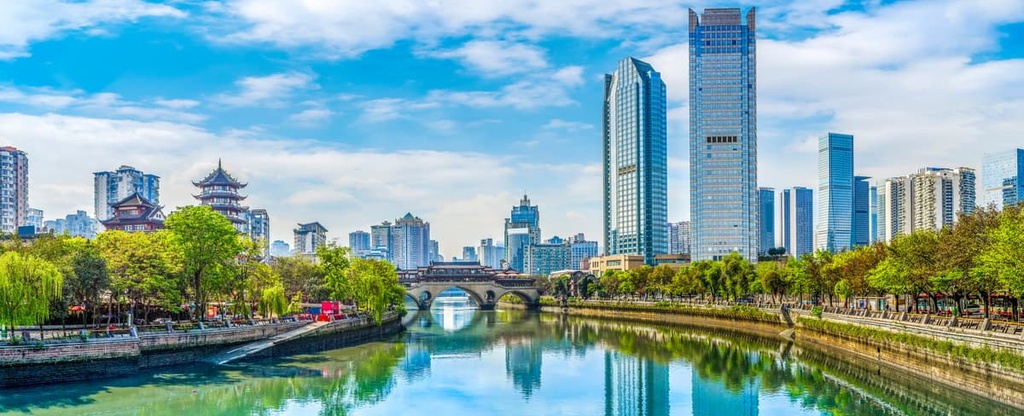
Chengdu has been a major center of culture, commerce, and political administration for more than a thousand years. It offers world-class attractions such as the Chengdu Research Base of Giant Panda Breeding, as well as the historic Kuan Zhai Alley and Jinli Pedestrian Street.
For a local experience, don’t miss the bold and spicy Sichuanese cuisine. Additionally, be sure to check out the Sichuanese opera, which features the stunt-like art of face-changing (变脸).
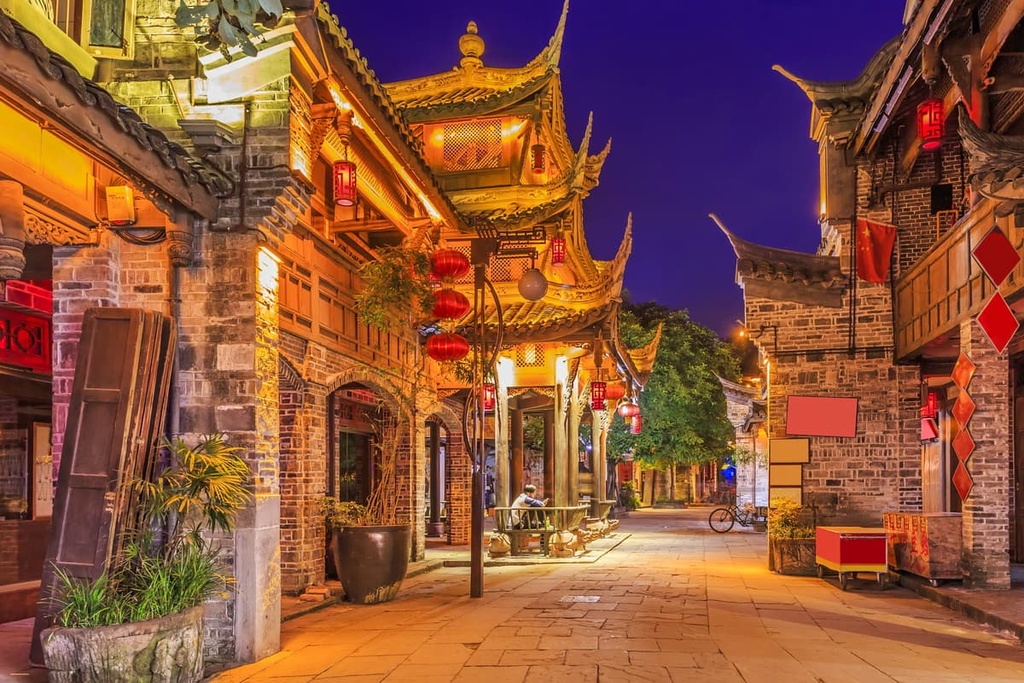
Explore Jiuzhai Valley National Park with the PeakVisor 3D Map and identify its summits.








